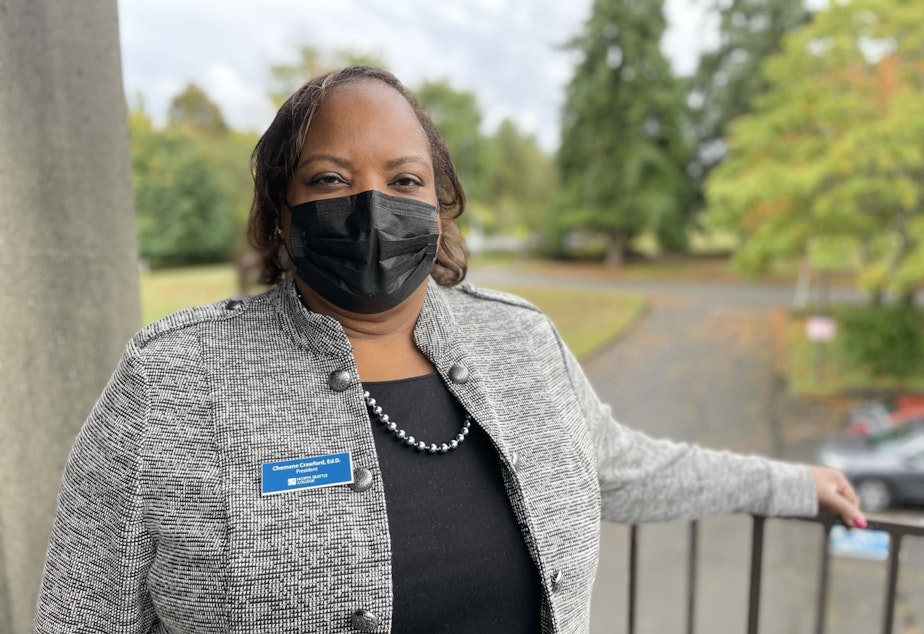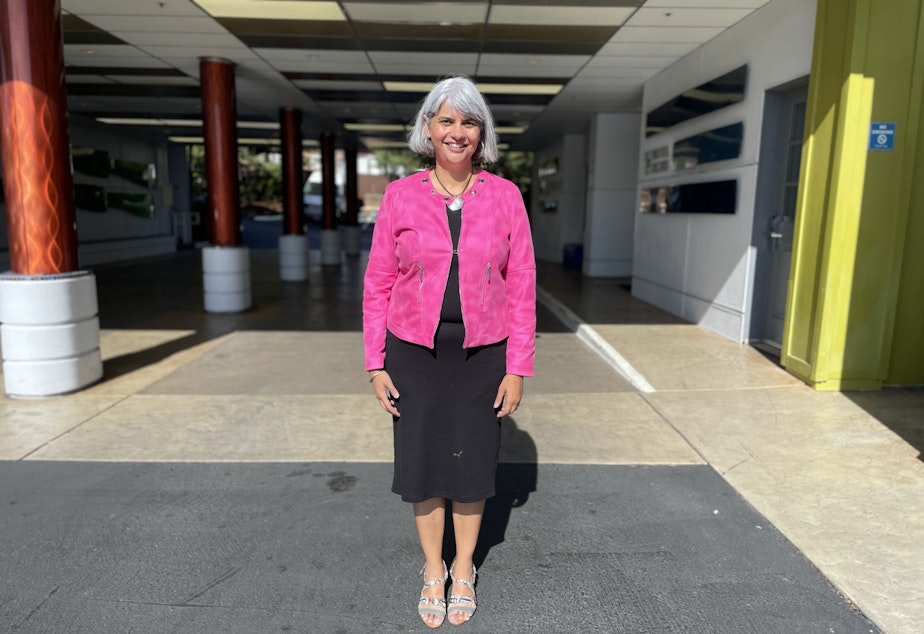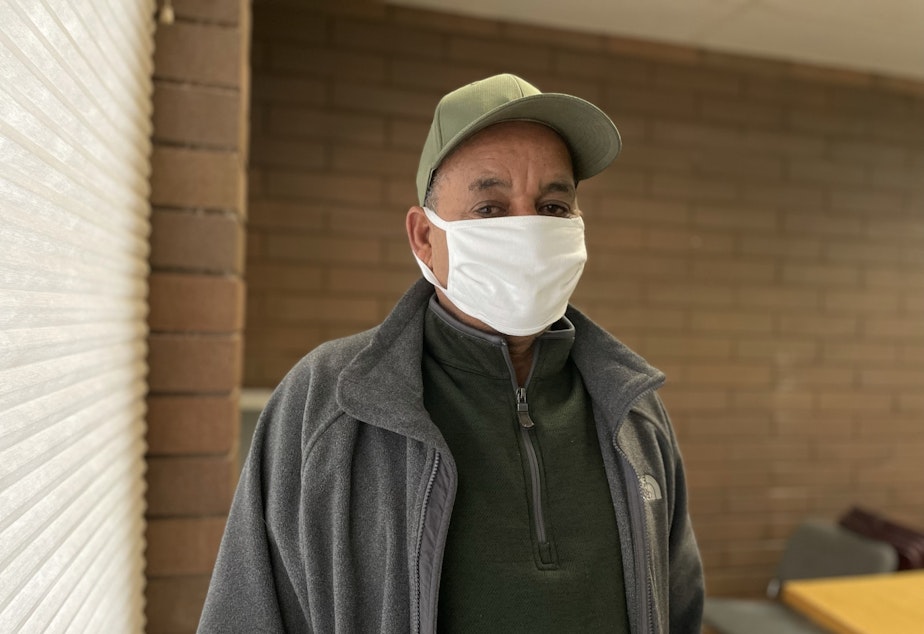Crowds of people tried Seattle's newest stretch of light rail this week, ending at Northgate. As they exited the station, many of them were greeted with a neighborhood undergoing massive change.
The first thing you may notice when you exit Northgate station is the site of the old Northgate Mall.
Shaun Kuo grew up across the street. He used to play with the wooden train sets at the local Toys R Us. Now he’s an urban planning student who writes for the Urbanist. He’s been tracking changes coming to what used to be the mall.
“We’re almost at the demolished Nordstrom,” he said, pointing to yet another part of the shopping center that now looks less like a mall and more like a sinkhole.
RELATED: Behind the art in North Seattle's new light rail stations
Simon, the owner of this property, is tearing most of the buildings down in phases and building a new neighborhood on private land. At its center is the Kraken Community Iceplex. Around that will be a little park, and something like an outdoor mall, with midrise office towers and apartment buildings above.

“How do you feel about these changes to the place where you used to spend so much time as a kid?" I asked Kuo.
“Very positive," Kuo said. "Northgate could use a change. When the mall was around, and before that, it was very much like a young suburb of Seattle."
But with light rail now open, Kuo said "it will be actually a part of the city, part of the urban core. Because the travel time between Northgate and Westlake is 15-ish minutes. It’s basically part of downtown at that point.”

Based on the permit activity Kuo's been tracking, he estimates the new development will be complete sometime in the mid 2020s.
In the neighborhood around it though, community stakeholders are getting new ideas about how to use their land.
North Seattle College is across the freeway from the new light rail station. A pedestrian bridge connects the two. College President Dr. Chemene Crawford says her campus was kind of isolated before the light rail arrived. People could see the campus from the freeway, but it wasn’t always obvious how to actually get there. But now, more people seem to be finding it.

For example, the college just formed a new fire science program – training people to be firefighters.
“The first cohort starts this fall, and the first two classes are full and we have a waiting list of 200 people,” Crawford said.
Crawford doesn't entirely credit light rail with having a role in filling those classes.
“I can’t say that. I don’t know for sure, but I do know that it makes sense that people would think, 'I can take the light rail and attend classes. I don’t have to worry about being in traffic – or the commute – or not even having a car. As long as I can take the bus, or the light rail – I can participate in this program.' So I would love to say yes, but we just don’t have enough data on that yet," Crawford said.
One thing the college president can say though, is that her new students are coming from all over King County.
Light rail has also changed how she thinks about her campus’ parking lots, and this campus has a lot of them. In the short term, she said the college is exploring renting them out as park and rides, or as overflow parking for Kraken Community Iceplex events.

But Crawford says she's starting to get a sense that the proximity to light rail makes this campus valuable to other people, too.
“So as an example, we’ve been approached about having events next year, if you can believe it, assuming we’re all out of pandemic mode.”
Events like "art fairs, car shows, you name it, right?"
"Because of, again, we have the open parking and all of that, and folks could take the train, walk across the bridge, and attend the art fair, the car show ... Instead of trying to find parking to do so,” Crawford said.
Another person whose dreams have grown is Shaiza Damji. Her family owns the Hotel Nexus, an older hotel near Northgate station that they’ve fixed up and added onto over the years. Now she wants the city to rezone her land so she can build much higher (up to 200 feet, or 20 stories).
“I feel that Northgate has been waiting to happen," Damji said.

And the arrival of the light rail station could be the key to ushering in a new era of development in North Seattle.
"I think that in other parts of the city – because so much of it has already happened – we haven’t been able to really think about – what would happen if you started knowing that there was already light rail,”Damji said.
She said that in other places light rail has come to, the neighborhoods around the stations were already fairly built up. But Northgate is a blank slate.
"Here, the whole area can redevelop based on the knowledge that light rail has come.”
Damji was careful to say the density should be contained in the area immediately near light rail, known as the Northgate Urban Center.
(Reporter's note: It's politically risky to promote dramatic upzones in single family zones such as those that surround Northgate's urban core).
With redevelopment comes opportunities, of course. But there are risks, too. One big question is how accessible and affordable it will be to live around this changing neighborhood.

Michael Neguse is a community organizer who works with East African immigrants in the neighborhood. He estimates there are thousands living there now, and that they’re underrepresented in the census.
Neguse said those families aren’t being included in conversations about the future of the Northgate area.
“The community’s not getting the news, what’s going on," he said. "That’s a problem.”
For instance, there's affordable housing coming to the neighborhood. Neguse said he wants to see more outreach to people living nearby so they aren’t displaced.
On the other hand, he said light rail will help his clients a lot.
“The light rail is really a blessing for the community. The people can go easily – most of them work in downtown, you know, they are service employees – and instead of taking cars, with a lot of insurance, and gas and parking [costs], it saves them a lot of money.”
When you look around our region, and see traffic congestion, it’s costing people time and money. In 2019, Seattle area commuters spent an average of 74 hours in traffic, according to traffic analytics company INRIX.
Light rail offers an cheaper, faster alternative. And as people cash in on those savings and switch to rail if and when they can, many of them will be spending more time in and around Northgate.
"light" - Google News
October 07, 2021 at 09:11AM
https://ift.tt/3ajRJ4K
With light rail as fuel, Seattle's Northgate is ready to grow - KUOW News and Information
"light" - Google News
https://ift.tt/2Wm8QLw
https://ift.tt/2Stbv5k
Bagikan Berita Ini
















0 Response to "With light rail as fuel, Seattle's Northgate is ready to grow - KUOW News and Information"
Post a Comment